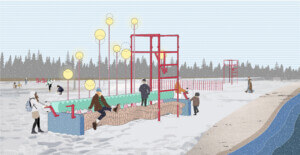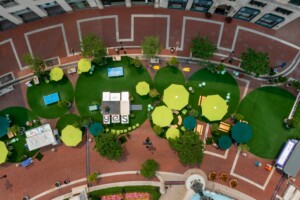The Urban Land Institute (ULI) has announced five finalists for the Urban Open Space Award, a competition identifying exceptional examples of flourishing public open spaces that have encouraged economic and social rejuvenation within their neighborhoods. To qualify for the competition, projects must have been open to the public for a minimum of one year and a maximum of fifteen years. The open spaces must also be situated predominately outside, offer ample and diverse seating, sun and shade, and plantings, among other specific requirements.
Brooklyn Bridge Park (Pictured at top)
New York, New York
Project Owner: Brooklyn Bridge Park
Designer: Michael Van Valkenburgh Associates
From ULI: More than 32 acres have been built, including Pier 1, Pier 5, Pier 6, Squibb Park and Bridge, and Jane’s Carousel. New elements include Pier 5, the park’s first active recreation pier, and Squibb Park Bridge, which provides a vital circulation link to the surrounding community and public transit. The park’s greenway serves as a major connective thread through the park and along Brooklyn’s East River waterfront.
Cumberland Park
Nashville, Tennessee
Project Owner: Metro Nashville Parks and Recreation Department
Lead Design Consultant: Hargreaves Associates
From ULI: Cumberland Park demonstrates Nashville’s commitment both to its children and to sustainability through brownfield remediation, floodplain preservation, stormwater harvesting, improved biodiversity, and interpretation of cultural and natural resources. It is a park that showcases its distinctive site qualities to attract families for imaginative play, events, and interaction with Nashville’s rich riverfront history.
Cumberland Park and the neighboring redeveloped Bridge Building are the first constructed phases of a master plan prioritized to draw residents and visitors back to the river and downtown.
The Village on False Creek
Vancouver, British Columbia
Project Owner: City of Vancouver
Designer: PWL Partnership Landscape Architects
From ULI: Located on a previously industrialized 80-acre waterfront site, The Village on False Creek, Vancouver’s premier sustainable neighborhood, exemplifies a new green-infrastructure-based approach to the public realm through the introduction of restored natural environments into a highly urban community.
The public realm is composed of Hinge Park, Habitat Island, a waterfront park, and neighborhood streets. Together they provide multiple and varied recreational opportunities while acting as kidneys for the neighborhood, cleansing stormwater runoff before it reaches the ocean.
The Yards Park
Washington D.C.
Project Owner: District of Columbia
Designer: M. Paul Friedberg & Partners; Developer: Forest City
From ULI: The goals of Yards Park are to bring Washingtonians to the Anacostia River, provide a transformative and vibrant public space, and generate social, economic, and ecological value.
Yards Park offers an eclectic blend of human-scale experiences; active and passive spaces; custom furniture, shade structures, and plantings; and differentiated elements such as a sculptural bridge, public art by Jamie Carpenter, and various circulation paths and water features.
In 5.7 acres, Yards Park eschews monumental scale for a series of outdoor rooms that rotate around central organizing elements of water and topographic change. Its programming strategy includes both large-scale festivals and smaller gatherings. Yards Park serves as cultural anchor to the Yards and the greater Capitol Riverfront area, reconnecting the city’s grid to the water.
Wilmington Waterfront Park
Wilmington, California
Project Owner: Port of Los Angeles
Designer: Sasaki Associates
From ULI: Wilmington Waterfront Park, comprising nearly 30 acres, mediates the relationship between the residential neighborhood of Wilmington and the intensely active Port of Los Angeles.
Reclaiming derelict, industrial brownfield land as new public open space, the park serves as a new recreational amenity while mitigating the threat of hazardous environmental waste, air and noise pollution, and dangerous industrial traffic from neighborhood streets. The park provides a safe, accessible new public realm; celebrates the vibrant community culture; interprets the site’s past; and creates a new memorable destination within a previously underserved neighborhood of Los Angeles.










